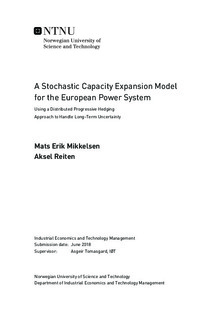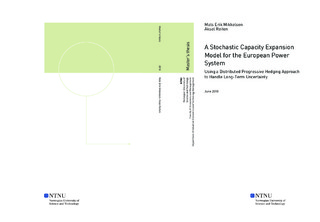| dc.description.abstract | In an attempt to limit the adverse effects of human-generated greenhouse gas emissions, the EU has set ambitious targets to reduce its domestic CO2-emissions by more than 80 percent from 1990 to 2050. The European power system has proven a significant potential for emission reductions, implying almost complete decarbonization of the sector in a time where both electricity demand and the share of intermittent, renewable power supply are expected to increase. To support policy makers in this transition, optimization based models are often used to study optimal capacity expansion pathways for the European power system. The task of modeling both technological details and economic behavior in a broad geographical and sectoral scope gives rise to substantial computational complexity, often resulting in the use of deterministic modeling approaches. Solutions from such approaches are, however, tailored to a particular realization of the future, neglecting the uncertain nature of many essential model inputs.
Several power system optimization models accounting for either long- or short-term uncertainty already exist, but models accounting for both have not been observed in the research literature. In this thesis, this gap is addressed by defining and formulating a mathematical model for the Long- and Short-term Stochastic Capacity Expansion Problem for Power Systems (LSSCEPPS). Central to the problem is the simultaneous co-optimization of long-term investment decisions and short-term operational decisions in the European power system over several decades, in the presence of stochastic long- and short-term input parameters. The primary objective is to find a sustainable, least-cost and robust development for the European power system while securing coverage of demand and complying with political regulations. To solve this problem, the EMPIRE model, a power system capacity expansion model developed at NTNU, is extended in this thesis to account for both long- and short-term uncertainty. This extension quickly results in intractable problem sizes for commercially available solvers, resulting in a need for improved solution methods.
In this thesis, a distributed progressive hedging algorithm is implemented to solve large instances of the EMPIRE model. The method decomposes the model by long-term scenario, iteratively solving decentralized subproblems in parallel. The performance of the algorithm is tested on a number of different problem instances under variation of both short- and long-term input data. It is demonstrated to be capable of solving instances of the EMPIRE model with more than 1.2 billion variables and 1.7 billion constraints, obtaining an optimality gap of 0.1 percent in 18 iterations after about 70 hours. The algorithm exhibits impressive convergence properties, generating tight gaps of less than 0.35 percent for all instances tested for in this thesis. It is further observed that the elapsed time required to solve instances with differing numbers of long-term scenarios remains roughly constant. This result illustrates the algorithm's profound scaling properties as long as sufficient computational resources are available, and implies that the convergence rate is mainly driven by the size and complexity of the short-term input data.
To verify the practical implications of including long-term uncertainty in power system capacity expansion models, a thorough analysis of the techno-economic implications of introducing stochastic CO2-emission restrictions is conducted. In a comparison of a long-term stochastic approach to a long-term deterministic approach, VSS-calculations display significant values of modeling both long- and short-term uncertainty compared to short-term uncertainty only, ranging from 7.9-11.6 percent for test instances with 8 or more long-term scenarios. Analyses further show that including fewer long-term scenarios results in a negligible VSS, indicating that a sufficient amount of long-term scenarios need to be assessed to capture the value of modeling long-term uncertainty.
The long-term stochastic approach is also proven to choose hedging strategies through increased investments in low-CO2 power generation and infrastructure that increases the flexibility of the power system, such as transmission, storage and more flexible thermal generation. These strategies are shown to yield slightly higher investment costs upfront, but with the benefit of vast reductions in future expected operational costs, indicating that politicians can significantly reduce the expected costs of power system capacity expansion by eliminating uncertainty about future energy policy. | |

